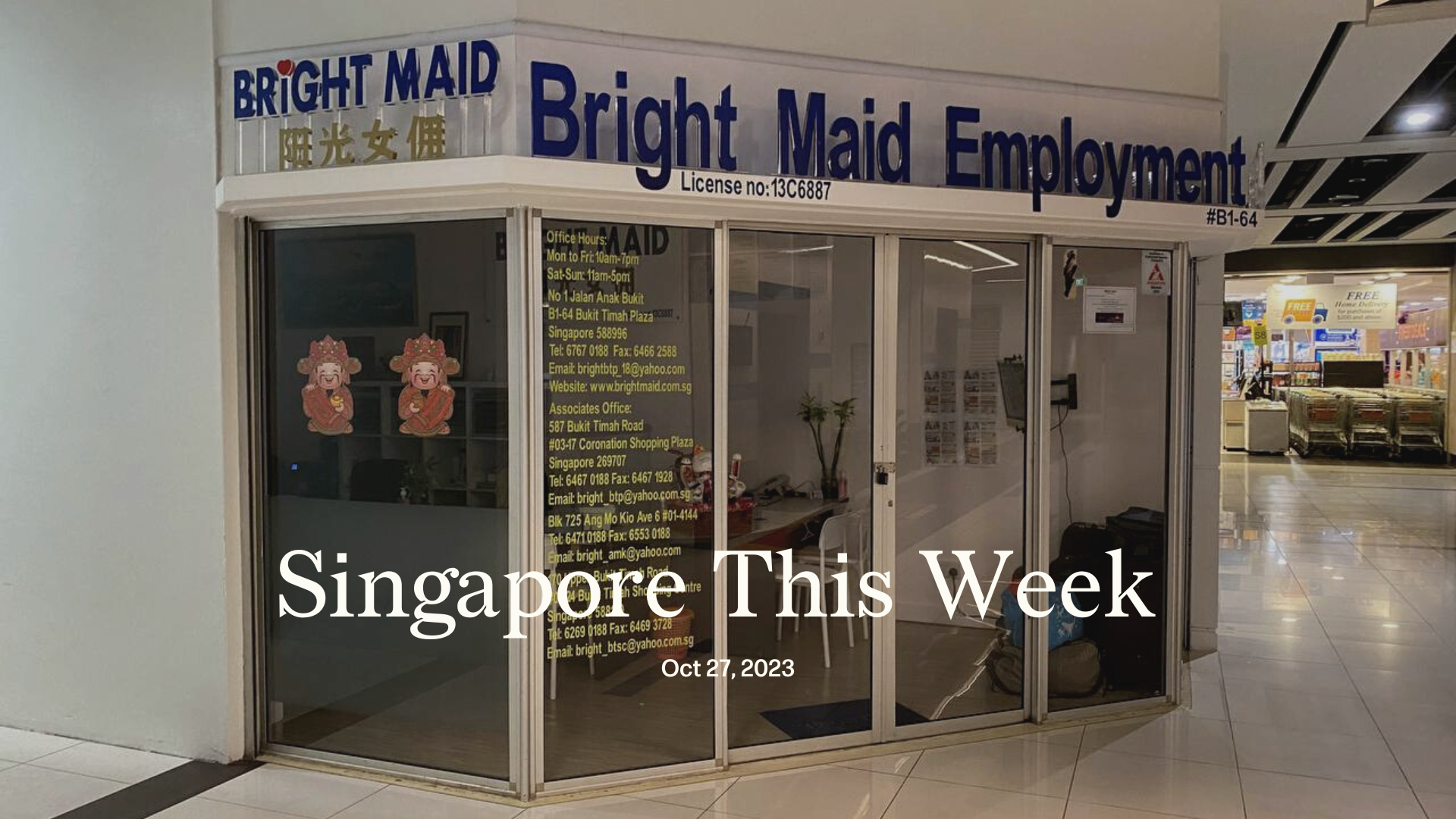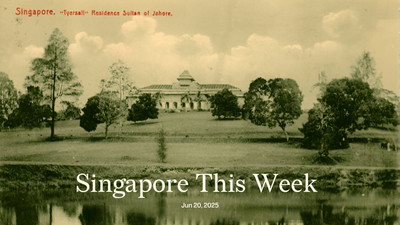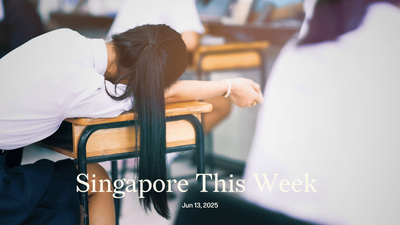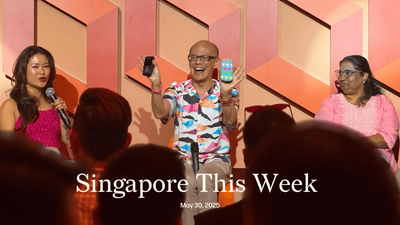Society: ‘How much is that Pinoy in the window?’
Indonesians are good value for money. Burmese are more docile and won’t push you for days off. Filipinos are intelligent and speak English but can be a handful. Before you next go maid shopping, brush up on these product specifications. Your friendly sales agent can help. Most have years of experience catering to demanding Singaporeans. They’ve even developed their own vocabulary to describe our South-east Asian neighbours who’ve come here to be leased to serve you. And, if you go home with something you later realise you didn’t actually want, no problem! Just exchange it. The returned product will be dressed down, refurbished, and repurposed as a tool in another household. And you, with your new maid, will once again be liberated from daily chores, like prepping your kids’ meals, so that you can maximise your labour for the higher-value jobs that you have to do in order to maintain your lifestyle. The system chugs along. This week, an article in The Straits Times reminded us of how Singaporeans objectify and commodify our fellow human beings. “Good value for money” and “affordable” ads are still emblazoned on agencies in Beauty World Plaza and Bukit Timah Shopping Centre. There you can witness some of the most depressing scenes in our “first-world” city: young South-east Asian women waiting wistfully for would-be employers, unsure if fate will hand them a demon or salvation. The Ministry of Manpower issued guidelines against such ads in 2014 following an exposé by Al Jazeera, though clearly agencies aren’t bothered about conforming. It’s a competitive market, mah–every little dehumanising edge helps. Karl Marx and others have talked about how the alienation of labour under capitalism deprives us of, among other things, our base humanity. Singaporeans probably want not revolution but reform. Language is power and we can each work on ourselves. We’ve made progress over the years: servant -> maid -> helper -> domestic worker. After all, they don’t “help” us because of some regional gotong royong; they perform essential work for us in exchange for (way too little) money. While we strive to address economic injustices, we can start to reclaim our humanity by treating others as humans. Dissuade those around you from using essentialising descriptions. It’s contagious and crippling to all. If you consider your “maid” a disposable good, just imagine how your CEO perceives you.
Note: “Karl Liew: the case against the prosecution”, by lawyer Carol Yuen, documents the shocking way Parti Liyani, a foreign domestic worker, was treated in the home of one of Singapore’s richest and most famous corporate honchos. It’s one of Jom’s most widely read essays.
Editor’s note: For our internal thought process behind this blurb’s headline, including the use of the word “Pinoy”, read this week’s newsletter.
Society: New kids on the (HDB) block
Meet Champion Charlie, Neutral Nancy, Quiet Quinn and Tolerant Tina—four profiles that were created based on a survey of residents’ levels of involvement in their community and their willingness to resolve issues themselves, rather than involve the authorities. The most willing to take ownership, the “Charlies”, represented 37 percent of the 1,050 respondents sampled, and were also the most satisfied with municipal services, like pest control, the cleanliness of public areas, the management of infrastructure and the maintenance of common facilities. The study by research firm RySense, and commissioned by the Municipal Services Office (MSO), found that four in 10 polled were willing to give back to their communities, like finding solutions to issues such as excessive noise, cluttering and second-hand smoke. In contrast, the “Nancies”, “Quinns” and “Tinas” each comprise 21 percent of the population and tend to remain silent about the affairs of their neighbourhood. But don’t take this acquiescence as a sign of approval; they’re also either neutral (read: indifferent) or less satisfied with the municipal services in their estates. MSO explained that the study supports the Forward Singapore exercise (aimed at strengthening the nation’s social compact), and reflects residents’ “high willingness” to engage in community-led projects to improve their living environment, especially when given the appropriate resources and support. Hence, it plans to train facilitators to lead grassroots initiatives and activate more residents to join, plan and implement projects. MSO will also develop a tool to determine a resident’s profile—Charlie, Nancy, Quinn or Tina, which can then be used to guide community efforts of engagement. Singaporeans have often been criticised for depending too much on the government to solve their problems—not helped perhaps by the G’s reputation as an overprotective “nanny state”. Ravi Menon, chief of the Monetary Authority of Singapore (MAS), once warned that an overreliance on a government breeds a society that won’t survive a bad government. So, it’s surely heartening to see more citizens taking matters into their own hands: becoming less socio-politically apathetic; and showing greater civic consciousness, as evident in this year’s labour and climate rallies. “Heck-care Harries” and “Languid Larries” could soon become relics of the past; a future that our leaders would do well to embrace, not fear.
Internet culture: Bare your soul, not your chest
What would you do if your boss whipped off his shirt to get a massage in the middle of a Zoom call? “Got to love Indonesia and AirAsia culture that I can have a massage and do a management meeting,” wrote Tony Fernandes, AirAsia CEO, on LinkedIn alongside a photo of him topless while a masked woman massaged his oiled-up shoulders. Fernandes has since deleted the post after receiving a wave of criticism about the impropriety of such behaviour. Commenters questioned if employees were genuinely comfortable with this office “culture”, or if they just didn’t feel empowered to challenge the CEO. “You can never really explain the thought process behind a post”, Fernandes explained to Bloomberg. Plus, he had just “endured” an 18-hour flight. Fernandes has twice before bared his chest on LinkedIn: once, when he announced the birth of his daughter with a photo of him cradling the newborn against his unclothed torso; and then when he shared his 2023 goals to “lose weight” and “be a better golfer”. André Spicer, professor of organisational behaviour at University of London’s Bayes Business School, has observed a recent management trend where CEOs and leaders are encouraged to be more authentic and relatable by “[bringing] their real selves to work”. Fernandes was ahead of the curve. He told CNN that he wanted “people to be themselves” in the workplace as early as 2007, and shared his aim of wanting to “be remembered for [creating] a great place to work at.” But what happens when the pressure to be authentic meets the performative nature of social media, specifically the tendency towards brown-nosing on LinkedIn? You get crying CEOs “griefposting” about having to lay off employees; broetry (its key characteristics include: a cheesy hook, single line paragraphs, cliche life lessons and rhetorical questions); and sometimes, morally reprehensible posts that leverage on international atrocities as a marketing strategy (“While Russia is taking over Ukraine, we’re taking over the Amazon event industry…Whoever can’t handle it, take shelter”). More people are expressing their annoyance and disillusionment with LinkedIn’s “toxic positivity” and know-it-all tech bros—subreddit LinkedInLunatics and Twitter account @StateOfLinkedIn each have over 300,000 followers. As corporate culture continues to bleed into the algorithm-obsessed, clout-chasing, clickbaity culture of social media, it’s likely we’ll have more outrageous and out-of-touch LinkedIn posts to look forward to.
Earth: Not going nuclear…yet
“Singapore has not made any decision to deploy nuclear energy,” said Gan Kim Yong, minister of trade and industry, in a speech at the Singapore International Energy Week 2023. Gan’s speech reaffirmed Singapore’s continued interest in the potential of nuclear energy, particularly in small modular reactors (SMR) to support Singapore’s energy mix by 2050. Many fear that nuclear plants carry unmitigable risks, primarily concerning safety and radioactive waste. Proponents of nuclear energy have an answer: SMRs are purportedly safer as they rely on passive systems and can be shut down without human intervention, lowering the odds of accidents. Nuclear waste? A solvable engineering problem, some experts say. Still, it might take the public more convincing: a 2021 survey showed that only one in five Singaporeans are in favour of nuclear energy development in South-east Asia. Meanwhile, we’re making good progress on renewable imports. This week, Singapore also announced a deal to import 1.2 gigawatts of low-carbon energy from Vietnam. In addition to imports of hydropower, solar and potentially wind energy from Indonesia, Cambodia and Lao PDR, this deal marks a milestone in our set target of importing four gigawatts (or about 30 percent of Singapore’s annual energy consumption) of low-carbon energy by 2035. But as attractive as renewables are, they come with their fair share of environmental and social problems. For example, analysts have criticised the import of hydropower from Laos due to its detrimental environmental and social impacts. More recently, conflict broke out on Rempang Island, following the Indonesian government’s plan to transform it into an “Eco-City” of solar and glass farms. Two thousand families are at risk of being dislocated from their ancestral lands. Singapore isn’t implicated, though it’s happening as we gear up to import solar energy from neighbouring Batam. All this is to say: there’s no perfect route to net zero. But it would be a great injustice not to consider every possible option—including nuclear—to mitigate the climate emergency.
History weekly by Faris Joraimi
For two weeks, the muddy and shallow mouth of the Selangor river kept the invaders at bay. It was July 1784, and a force comprising 11 ships of the Dutch East India Company (Verenigde Oostindische Compagnie, or VOC) and several others belonging to their ally, the Sultanate of Siak in east Sumatra, could not land. Retaliating against a prior joint invasion by Selangor and Riau against Dutch-ruled Melaka, they bombarded the stone fortress of Kuala Selangor, then the headquarters of Selangor’s Sultan Ibrahim Shah (1736-1826). Finally, on August 2nd, the tide rose and the attack began. Their advance was swift, but not without resistance. Sultan Ibrahim’s chief advisor, Panglima Besar (“Grand Commander”) Tengku Sayid Jafar, fired at the enemy as they approached, before defending his house in hand-to-hand combat. Attempting to burn down the town and leave nothing for the Dutch to capture, he tried setting his house on fire before escaping, but failed. Sayid Jafar fled upriver, as Kuala Selangor fell. What was inside that house? Earlier this month, Annabel Gallop, head curator of Southeast Asian Collections at the British Library gave a talk for Malaysia’s International Islamic University (IIUM), about one thing that survived: Sayid Jafar’s personal library. It was taken back to the Netherlands by the VOC commander Jacob Pieter van Braam, who gifted it to the university in his hometown, Harderwijk. Comprising 72 volumes, it’s a rare and fascinating snapshot of what a Malay nobleman and bibliophile read in the 18th century: grammar texts, dictionaries, the Qur’an, books of religious law, and poetry praising Prophet Muhammad, all mostly in Arabic. A smaller number are works in the Bugis language and script, including a fragment of the Bugis creation story, La Galigo. There are a few Malay letters, and sheets of charms and spells. Some of the volumes are elaborately ornamented. All were either produced in port-cities around the Malay world or Arabia, reflecting a culture of Muslim literacy that connected distant parts of the Indian Ocean. The oldest book in Sayid Jafar’s collection was copied in 1603, which is unusual given how relatively few manuscripts in the Malay world from before the 19th century have survived the decay caused by tropical humidity. Now housed at the Athenaeum Library in Deventer, some items from the collection were digitised in 2022 and can be viewed on its website.
p.s. Libraries are beacons in dark times. Here are four reading lists featuring works by both Israeli and Palestinian authors to start off anyone wanting to learn the history behind the ongoing siege of Gaza.
Arts: Old stories and future visions at ArtScience Museum
Does science fiction have anything to do with Asian philosophy and mythologies? According to the ArtScience Museum, yes. “New Eden: Science Fiction Mythologies” explores the intersection of these ideas through culture in its myriad forms. Artworks by women artists and collectives are presented alongside historical artefacts from the Asian Civilisations Museum and video excerpts from science fiction films. The exhibition begins with a nerdy look at developments in science fiction through a timeline, in which each ‘time period’ in science fiction is accompanied by a selection of key books that explore particular ideas or themes that are representative of the era. Some highlights include Sultana’s Dream, by Begum Rokeya, which is regarded as the first science fiction novel by an Asian woman and The Black Tides of Heaven by Neon Yang, a “silkpunk” novella that is part of the Tensorate series which plays with form and storytelling to challenge understandings of gender. The exhibition reminds us that the ideas explored in science fiction exist in art, cultures, and communities—it invites visitors to find connections and resonances across these realms. The exhibition also, in the words of co-curator Honor Harger, celebrates dream worlds, future visions and fantastical realities, showing that women and alternative voices are calling for a more inclusive future. Set aside time for the exhibition—the artworks invite audiences to explore entire worlds in themselves. Several artworks reveal their secrets over time. If you look closely, and at the right time, Chok Si Xuan’s “latent” breathes gently and slowly. Sputniko!’s “Red Silk of Fate – The Shrine” features a “music video” that blends fact and fiction to tell the story of Tamaki, a genetic engineer who makes her own “Red Silk of Fate” in the hopes of winning the heart of her crush. In one gallery, visitors are invited to sit down in a pink gaming chair of sorts to dive deep into a 3D exhibition produced by PACK.
Arts: ‘Concert hub’ Singapore, keeping it ‘LV’
Blackpink in your area! But also, Jay Chou, Jacky Cheung, Sam Smith, Mayday, Coldplay, Taylor Swift and Ed Sheeran. If you’re a fan of live experiences, it is both a wonderful time (for attending concerts) and a terrible time (for your wallet, especially if you get a resale ticket) to be alive. The desire to see one’s faves in concert and to breathe the same air as them is at an all-time high. Fans are willing to brave the heat in long queues for tickets or prep multiple devices just for a shot at a ticket. As iconic acts take on larger stadiums in Singapore, other acts are playing smaller, diverse venues like Pasir Panjang Power Station, Marina Bay Sands or even Esplanade. The wider tourist industry that provides hospitality for artists, industry workers and attendees also benefits from the concert high. And while it is true that Singapore has had the good fortune of hosting many sold-out concerts, how long can this last and whose support is required to maintain it? Will such a high demand for concerts persist as the global economy weakens and wallets tighten? While Singapore intends to continue to be the “LV destination”, neighbouring countries would also want to bring concerts to their much larger domestic audiences, and might wish to become the only Asian or South-east Asian stop on an artist’s tour. Overall operating costs have also increased after the pandemic. But despite these challenges, it seems like what sets Singapore apart will continue—good infrastructure, connectivity (to the world, and within Singapore itself), and the widespread use of English. (Our neighbours bemoan their own countries’ inability to compete with us for global superstars.) The government, meanwhile, seems invested in turning Singapore into a concert hub, partly to drive tourism. Charlie Puth, Jackson Wang and Billie Eilish have all held concerts in Singapore and all worked with the Singapore Tourism Board SingapoReimagine campaign. Eagle-eyed Swifties might also have noticed the SG Passion made Possible logo on her marketing collateral.
Tech: From Singapore to the Moon
Can a small city-state like Singapore have a seat at the table when it comes to space exploration? Recent funding successes of local space tech companies suggest so. Singapore-based space firm, Qosmosys, announced securing a substantial US$100m (S$136.8m) in seed funding for their development of ZeusX, a lunar mining vehicle. The ambitious start-up, with branches in France and the US, plans for a prototype to land on the moon by early 2027 and begin mining. Its founder and CEO, Francois Dubrulle, currently lives in Singapore and has had over 30 years of experience in aerospace. Airbus Defence & Space, his former employer, provides Qosmosys with crucial design and engineering services. Qosmosys aims to extract vital resources like the helium-3 isotope, which could be used on Earth for nuclear fusion to generate energy. Additionally, the exceedingly versatile Zeus platform, comprising a service module, moon lander, and a Lunar Integrated Bulk Extraction Rover, will bring payloads such as scientific equipment and robots to the moon. It can carry up to 500kg of microsatellites to a cislunar orbit or 800kg payloads to the Moon’s surface, fulfilling several needs. The considerable financial commitment by investors reflects increasing interest in space mining and exploration. UK-based Seraphim Space Accelerator also recently expanded into Singapore, and plans to make this its regional hub for Asia Pacific. Today, Singapore is home to several venture-backed Spacetech start-ups such as Transcelestial, NuSpace and Equatorial Space. This is unsurprising given the government’s support of the local space industry, including its planned S$150m investments into space-tech R&D. Should all go to plan, Singapore will hope to play a crucial role in the lunar extraction industry by the end of the decade. Many challenges remain, including technical feasibility, economic viability, and legal and environmental concerns. Yet if Singapore does succeed, it’ll be in keeping with form: exploiting resources far away to keep our little bubble pristine.
Tech: Making travel and SME payments better
Remember the days when you’d have to visit your neighbourhood money changer before travelling overseas? Say goodbye to that with YouTrip’s travel payment solutions. The Singapore-based fintech firm has raised a US$50m (S$68.4m) Series B funding, led by Lightspeed, bringing the total amount raised to US$100m (S$136.8m) since its founding in 2018. The money will be used to hire over 100 personnel and develop its product technology. As an institution licensed by the MAS, YouTrip offers a trove of services including payments, foreign exchange, remittances, and cards. The company can boast of US$10bn (S$13.6bn) in annualised transaction volume, and a remarkable 238 percent growth in e-commerce payment volume since its Series A in 2021. Beyond enabling easier travel payments, YouTrip also has rolled out YouBiz, a corporate card aimed at small and medium-sized enterprises (SME). While consumer spending growth can be attributed to post-pandemic travel recovery and e-commerce uptake, YouBiz has rapidly onboarded over 3,000 companies since its inception, with plans to double this figure by next year. The firm aims to leverage artificial intelligence for personalised features and expand its service offerings for SMEs. It also plans to expand regionally, including to Indonesia, Malaysia, the Philippines, and Vietnam. Notably, Lightspeed is also an investor in SME neobank Aspire, which recently raised US$100m (S$136.8m) in its Series C round. One wonders whether the two firms will benefit from a stronger partnership with a common investor onboard.
If you enjoy Jom’s work, do get a paid subscription today to support independent journalism in Singapore.








